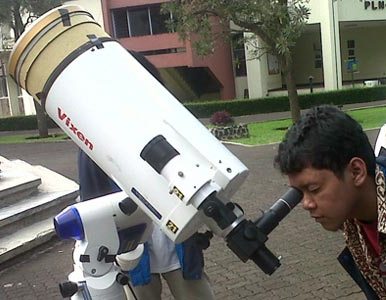Himastron ITB Held Transit of Venus Observation
By Diviezetha Astrella Thamrin
Editor Diviezetha Astrella Thamrin

 BANDUNG, itb.ac.id - A rare alignment where Venus passes directly across the solar disk was happened on last Wednesday (06/06/12). Astronomy Student Association (Himastron) ITB held an observation of this phenomenon around Oktagon Building ITB. The observation was opened for public, using available telescopes provided by Himastron.
BANDUNG, itb.ac.id - A rare alignment where Venus passes directly across the solar disk was happened on last Wednesday (06/06/12). Astronomy Student Association (Himastron) ITB held an observation of this phenomenon around Oktagon Building ITB. The observation was opened for public, using available telescopes provided by Himastron. There were three telescopes provided by Himastron ITB. "This phenomenon can't be seen with bare eyes," said Muhammad Zamzam as The Head of Himastron ITB. Besides using telescopes, the observations could also be done using sun glasses, sun funnel, sun potter, pinhole projector, and others.
Using telescope, the sun was looked as if it has a mole. The distant planet, Venus, was seen as a small dot gliding slowly across the face of the sun. "It is because of the size of Venus which is much smaller than the size of The Sun itself," said Zamzam.
In Bandung, the Transit of Venus phenomenon was happened around 05.14 AM to 11.48 AM. This was the last time Transit of Venus happened in this century, because the next phenomenon will be happened in December 2117. Hence, the Transit of Venus observation held by Himastron ITB from 08.00 AM until 12.00 WIB. "What we can see here from Bandung only when Venus starts entering the Sun until it goes out," explained Zamzam.
Very Rare Phenomenon
 Transit of Venus is a phenomenon when the planet Venus passes directly between the Sun and Earth, and therefore is in one straight line along with the Sun and Earth. This phenomenon is almost similar with a lunar eclipse or a solar eclipse. If this is observed, the planet Venus will be seen as if it stains the Sun.
Transit of Venus is a phenomenon when the planet Venus passes directly between the Sun and Earth, and therefore is in one straight line along with the Sun and Earth. This phenomenon is almost similar with a lunar eclipse or a solar eclipse. If this is observed, the planet Venus will be seen as if it stains the Sun.
"The pattern of two transits is happened with an 8 years-interval. Then, the following transit will be happened 121 years later. After that, there will be another 8 years-interval for the next transit, and 105 years-interval. Then, the whole pattern is repeated again," explained Bosscha Observatory Director, Dr. Mahasena Putra.
This phenomenon is very rare because if Venus passes across the Sun and Earth, it is usually not in parallel state. "This phenomenon can be seen again in more than one century from now," explained Dr. Mahasena.

.jpg)

.jpg)
.jpg)
.jpg)

